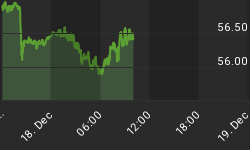The resilience of the broad market in the face of the drop in the face of the Fed's interest rate policy - and in spite of the historical/seasonal weakness of September - is a testimony to the peaking of the 6-year cycle. We've discussed the effects of this cycle throughout this year and it has proved an invaluable aid to keeping the various market segments buoyant since the April/May lows.
Recent newspaper headlines attest to these consumer confidence fears. Consider the following extraction: "Analysts fear fragile confidence," "Storm threat and prospect of more rate rises make investors nervous," and "The hidden threat of a housing slowdown."
But another important, and often overlooked, factor has been the lingering waves of forward momentum that have suffused throughout the broad market and have benefitted nearly every major market sector since the spring turnaround, including the gold stock sector. The upward waves of momentum that have been there underlying the market since the April bottom are still lingering but are getting thinner after each immediate-term cycle bottom, a consequence of the fact that we're nearing the end of the 6-year cycle peaking process.
Now that we're about to enter a month that has been known to be turning points for bull and bear markets alike, what are the sectors most likely to benefit from these momentum waves in October? There are a few key sectors, including metals and mining stocks, that should maintain a continuance, to some degree or another, of the near-term waves of upward momentum that is still rippling across many areas of the broad market as the 6-year cycle peaking process continues.
The Dow Jones Utilities Average (DJUA) has been a major beneficiary of the momentum upward wave this past summer, making it one of the leading momentum sectors in the broad market. That lingering momentum hasn't died yet and should keep the utilities afloat in October and allow for another high to be made. The dominant interim moving averages identify this momentum trend in the utilities sector as shown below.

Worth mentioning is that leading U.S. companies continued to buy back their own shares at a rapid pace during the second quarter, according to Standard & Poor's (as reported in the FT). S&P said buyback activity by companies in the S&P 500 index grew 92 percent in the second quarter compared with the same period last year. The total of all buybacks in the second quarter reported by S&P was $82 billion. This trend toward buybacks by companies reduces shares outstanding and was one of the things that helped sustained those waves of upward momentum across the broad market since then. It has kept selling pressure from becoming a major factor whenever short selling activity has become pronounced. However, as we head closer to 2006 and when the 6-year cycle finally peaks, the market should eventually feel the pressure from the falling 8-year cycle which is due to bottom later next year.
But by far one of the best sectors from a momentum standpoint remains the gold stocks, which continue to enjoy the benefit of those lingering momentum up-waves heading into October. The short-term chart of the XAU index still looks sound from a momentum and relative strength standpoint as reflected in the dominant interim moving averages shown below.

The silver stock sector also still has the benefit of riding a wave of momentum entering October. Leading blue chip silver stock Pan American Silver is one of these beneficiaries, which we reviewed as a top momentum stock back in. The configuration of the dominant interim 30/60/90-day moving averages reflects this.

Along with the gold and silver stock sectors, another major sector that will be important to monitor in the weeks ahead will be real estate equities. As we discussed in a previous commentary, the trend of the real estate sector is closely tied with that of the gold price and since both commodities are considered inflation hedges. The 30-week moving average of the leading property stocks is still rising and wave form analysis suggests that this sector should be able to remain buoyant and perhaps edge slightly higher until the next cycle peak.
A short-term rebound in select real estate equities will be helped by the extreme manifestation of bearish sentiment surrounding real estate right now, as witnessed in a slew of recent news stories and magazine covers.
Consider for instance the recent front cover of The Economist magazine, which featured a falling brick inscribed with the words "house prices" and headlined "After the fall." Then there has been the recent spate of newsletter advertisements that you may have received in your mail box of late warning of an imminent "housing bust." This much bearish sentiment on housing - from a contrarian standpoint - cannot do anything but keep the market afloat until the bearishness subsides by a considerable degree.















